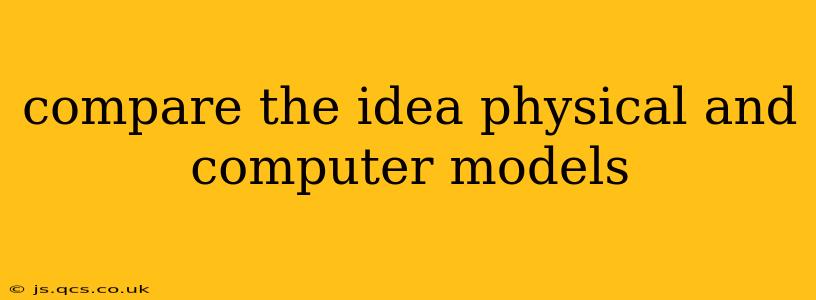Comparing Physical and Computer Models: A Deep Dive into Similarities and Differences
Choosing between a physical model and a computer model depends heavily on the project's goals, resources, and the nature of the system being modeled. Both approaches offer unique advantages and disadvantages. This comparison will explore their key differences and similarities, helping you determine which is best for your needs.
What is a Physical Model?
A physical model is a tangible representation of a system, object, or process. It's a scaled-down or scaled-up version, often built from materials like wood, plastic, or metal. Think of architectural models of buildings, airplane models in wind tunnels, or even a miniature replica of a human organ for surgical planning.
Advantages of Physical Models:
- Intuitive understanding: They offer immediate visual comprehension, making complex systems easier to grasp, especially for non-technical audiences.
- Tangible interaction: You can physically manipulate them, testing different scenarios and observing direct consequences.
- Suitable for complex geometries: Physical models excel in representing intricate shapes and designs that are difficult to replicate digitally.
- Verification of design concepts: Allows for early detection of design flaws and facilitates adjustments before committing to full-scale production.
Disadvantages of Physical Models:
- Costly and time-consuming: Building physical models can be expensive and require specialized skills and materials.
- Limited scalability and flexibility: Changes and modifications are often difficult and expensive to implement.
- Not suitable for dynamic processes: Representing dynamic processes like fluid flow or chemical reactions accurately can be challenging.
- Potential for errors in construction: Human error during the construction phase can lead to inaccuracies in the model.
What is a Computer Model?
A computer model is a virtual representation of a system using software and algorithms. It simulates the behavior of the system based on mathematical equations, data, and algorithms. Examples include simulations of climate change, weather forecasting models, or finite element analysis (FEA) for engineering designs.
Advantages of Computer Models:
- Cost-effective: Generally cheaper and faster to develop than physical models, especially for complex systems.
- Flexibility and scalability: Easy to modify parameters, conduct multiple simulations, and scale up or down the model as needed.
- Suitable for dynamic processes: Effectively simulate dynamic processes and predict behavior over time.
- Precise and repeatable: Eliminates human error inherent in physical model construction, leading to more repeatable results.
Disadvantages of Computer Models:
- Requires expertise: Developing and interpreting computer models requires specialized skills and knowledge in programming and simulation techniques.
- Limited sensory experience: Lacks the immediate visual and tactile feedback offered by physical models, making it harder to understand for some.
- Validation challenges: Ensuring the accuracy and reliability of computer models can be difficult and requires rigorous validation.
- Computational cost: Simulating highly complex systems can require significant computational resources and time.
What are the Similarities Between Physical and Computer Models?
Both physical and computer models aim to:
- Represent a system: They both create simplified representations of real-world phenomena to study and understand them better.
- Predict behavior: They both help predict how the system will behave under different conditions.
- Test hypotheses: They both provide a way to test different hypotheses and scenarios before implementation.
- Improve understanding: They both ultimately improve our understanding of the system being modeled.
What Model is Right for Me?
The choice between a physical and computer model depends on the specific application. Often, a hybrid approach combining both is the most effective solution. For example, a physical model might be used for initial design visualization, followed by a computer model for detailed analysis and simulation.
Frequently Asked Questions
Q: Can a physical model be used to test dynamic systems?
A: While challenging, it's possible. For example, a wind tunnel uses a physical model to test the aerodynamic properties of an airplane, which is a dynamic system. However, computer models are generally better suited for simulating complex dynamic behavior.
Q: Are computer models always more accurate than physical models?
A: Not necessarily. The accuracy of both depends on the quality of input data, assumptions made during modeling, and the limitations of the chosen method. Computer models can be prone to errors in algorithms or insufficient data, while physical models can suffer from construction errors or inaccurate scaling.
Q: What is the role of validation in both physical and computer modeling?
A: Validation is crucial for both. Physical models are validated by comparing their behavior to real-world observations. Computer models are validated by comparing their predictions to experimental data, other models, or real-world observations.
Q: Which model is more expensive?
A: Generally, physical models are more expensive to create and maintain than computer models, especially for complex systems. However, the cost of developing and running sophisticated computer models can also be substantial.
